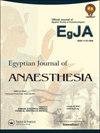Continuous thoracic epidural versus continuous paravertebral analgesia in patients undergoing open renal surgery: Evaluation of pulmonary function; randomized double-blinded clinical trial
IF 0.5
Q3 ANESTHESIOLOGY
引用次数: 0
Abstract
ABSTRACT Background This study aimed to assess pulmonary functions after either continuous thoracic paravertebral block (cTPVB) or thoracic epidural block (cTEB) in open renal surgeries. Methodsː The double-blinded, randomized clinical trial included 40 patients scheduled for open renal surgeries at Urology Hospital-Assiut University, equally assigned into group E (n = 20) and group P (n = 20), both at the level of 7th-8th thoracic vertebra. Initially, 7.5–12 mL of bupivacaine 0.25% was started before the induction of general anesthesia, followed by bupivacaine 0.125% continuously at a rate of 5–15 ml/h. Forced vital capacity (FVC) measured every 6 hours postoperatively within the first 24 hours was the primary outcome. Secondary outcomes were peak expiratory flow rate (PEFR), forced expiratory volume in the first second (FEV1), diaphragmatic excursion (DE), postoperative analgesia, total opioid consumption, total local anesthetic dose, hemodynamics and complications. Resultsː FVC, FEV1 and DE were better preserved in cTPVB where the lowest postoperative readings as a fraction of preoperative control were 0.7 ± 0.11 vs 0.65 ± 0.11 L, 0.74 ± 0.11 vs 0.64 ± 0.10 L and 0.73 ± 0.1 vs 0.58 ± 0.1 cm, respectively. The lowest postoperative PEFR was reported in cTEB (p-value = 0.128). Analysis of numeric rating pain scale, total opioid consumption and time of first rescue analgesic request revealed a statistical nonsignificant difference. The total infused dose of local anesthetic was significantly higher in cTPVB group. Incidence of sympatholytic complications was higher in cTEB. Conclusion cTEB and cTPVB had convergent effect on respiratory function and diaphragmatic motility and equivalent analgesic efficacy after open renal surgeries. Although cTPVB was technically easier and less time-consuming than cTEB, higher dose of local anaesthetic was required in cTPVB.开放性肾手术患者连续胸椎硬膜外镇痛与连续椎旁镇痛:肺功能的评价随机双盲临床试验
本文章由计算机程序翻译,如有差异,请以英文原文为准。
求助全文
约1分钟内获得全文
求助全文
来源期刊

Egyptian Journal of Anaesthesia
Medicine-Anesthesiology and Pain Medicine
CiteScore
0.90
自引率
0.00%
发文量
78
 求助内容:
求助内容: 应助结果提醒方式:
应助结果提醒方式:


